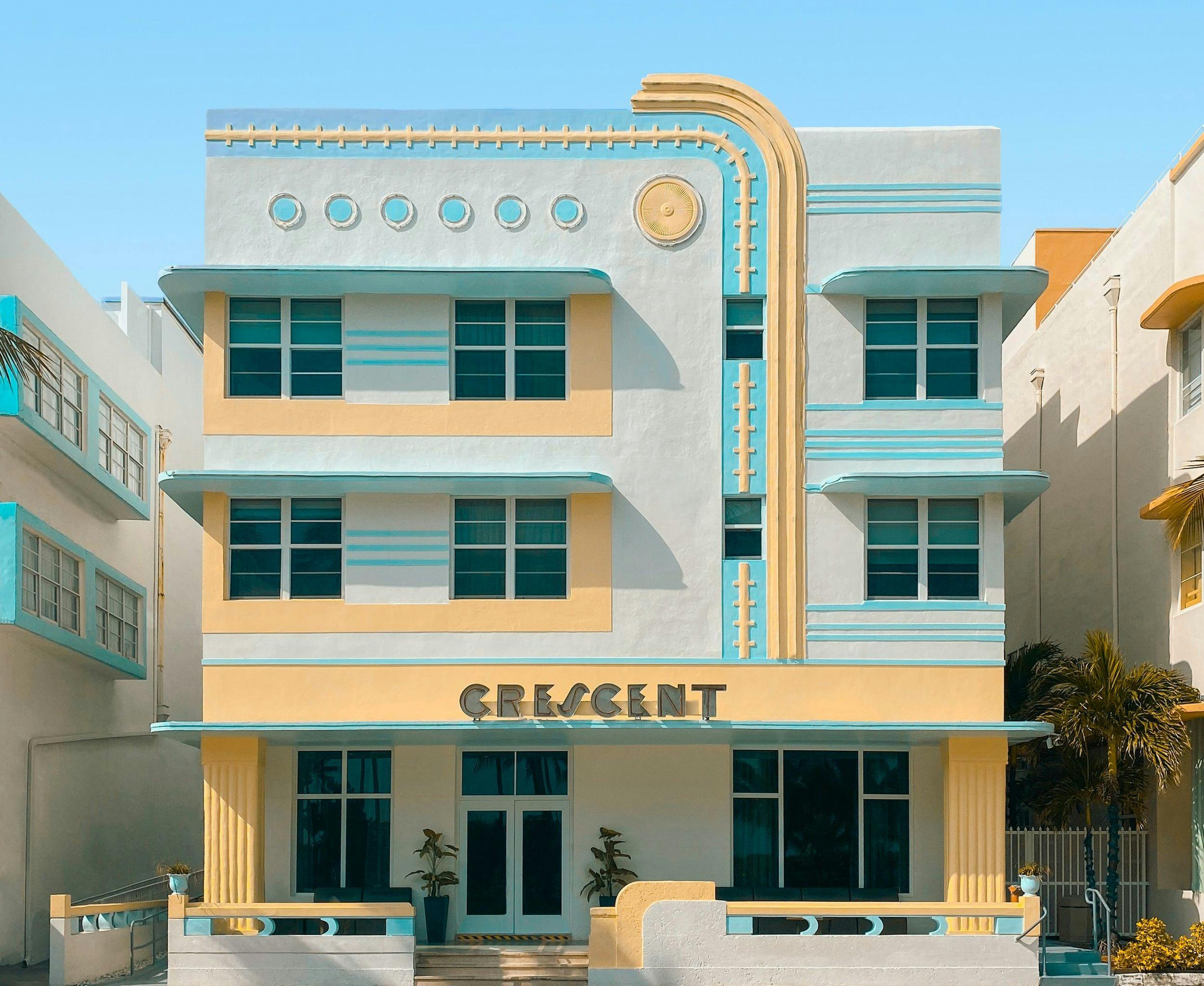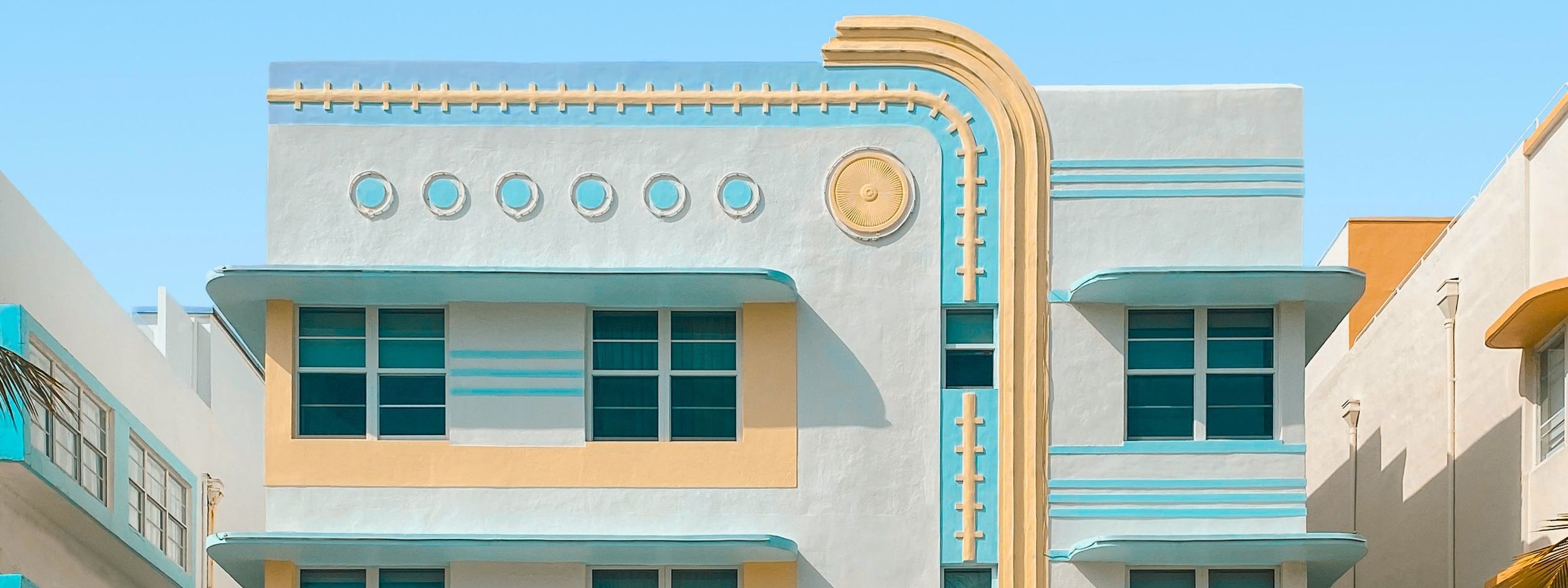Art Deco Architecture: Miami Project Directors Weigh In on the Fresh Yet Nostalgic Style
May 11

As you drive across Miami Beach, you notice strong geometric lines, eye-catching bright colors and pastels, fountains, and chrome accents. This is art deco. Though the craze for deco was nationwide, it found its best and most long standing home alongside the beaches of Miami. The distinct, beautiful look of these buildings has added to the city’s unique character, enhancing its already sumptuous color pallets and ocean views.
Miami is home to the largest concentration of Art Deco buildings in the country. The abundance of these 1920’s and 1930’s style buildings adds an unmistakable flair to the area, drawing throngs of tourists, historians, and architecture buffs each year to see it for themselves. While many can recognize an Art Deco building or home when they see one, few - including me- understand the historical significance or why there are so many in Miami in the first place!
I wanted to learn more about these beautiful buildings, so I sat down with some of our Miami-based project directors to get the details straight from the experts. We covered topics from Art Deco origins to remodeling tips to personal favorite buildings in order to get a better understanding and appreciation for this beautiful architectural design that is so beloved by Miami residents.
Let’s meet the project directors!


Can you give some background about why the Art Deco influence is so prominent in the Miami area?
Melanie: Miami Beach first became popularized as a vacation destination in the early 1900s by developer Carl Fisher. During that time, Art Deco was an influential design movement that was extremely popular in Europe, and embraced modern, geometric patterns that exemplified the glamor, opulence, and fine craftsmanship of the roaring 20s. The Art Deco style of the buildings and art found in Miami is part of the “second wave” of the movement that was generated after the Great Depression, and focuses more on the machine-inspired forms of the industrial revolution.
Despite the second Art Deco movement being a reaction to the difficult times the country faced, it was expressed in a way that suggested an optimistic future through the bright pastel colors, symmetry, decorative sculptural panels, window “eyebrows” and rounded corners. This architectural style has become synonymous with Miami Beach, and many people identify the Art Deco movement with this vacation destination, which makes it all the more a unique and special place to visit. It also serves as a reminder that despite any hardships we may collectively experience, there will always be better times ahead and a brighter, more colorful future awaits!
Jesús: Miami became an important getaway hotspot during WWI. In their developments, builders decided to go with one of the most current trends that reflected the shapes of the new future for America. That got mixed with the idea of bringing happy colors of the tropics that distance from the metal, bricks and glass of the northeast cities.
What are some of the core elements of Art Deco? For someone who knows very little about the style.
Jesús: Art deco is an art, design and architectural movement that is based on the decorative arts. There are two main trends. The first one I like to call “Great Gatsby,” which ran from 1910 to 1930. You see it in buildings such as the Empire State Building or the Chrysler Building. The second is “Streamlined,” roughly 1930 to 1940, based on a more geometric architecture with vibrant colors, mostly pinks and other pastels. The difference between these two stems from the Great Depression: while the Great Gatsby movement is more lavish and luxurious with lots of molded metals, Streamlined focuses on more simple details, bringing in postwar materials such as plastic, vinyl and aluminum.
Josh: Some of the core elements in the Art Deco look are the bold use of pastel colors, like blue, pink, yellow, orange, and at times lavender. You’ll also notice some picture cube-style or porthole windows. The flooring is usually the basic polished terrazzo flooring, which is now coming back. I love most of all the embellishments used on the side of buildings, with big floral expressions, statues, and sometimes large bold curves and cut outs.

When remodeling or working on upgrading an Art Deco home, what are some of the elements that you pay special attention to or watch out for?
Josh: I consider the overall look of the space and what can be preserved in its current state. I think when remodeling an art deco home, you need to be careful not to fringe one style with another. At times using a more eclectic approach will get you better results.
Jesús: It is most important to respect harmony and the shapes. The streamlined forms and the geometrical elements are BIG YES’es! Art deco is one of the most accessible styles to upgrade due to its lack of embellishments. Just follow the retro patterns, pastel tones, and rounded borders. On the other hand, avoid romantic or intricate details, dark or earthy tones, or plastered textures.
Melanie: I actually worked on a historic art deco style condo building in the past! Special attention was given to the intricate detailing of the ceilings and walls so that it could be properly replicated and restored. Additionally, the original materials had been stripped from the building, so researching and procuring the same or similar materials was extremely important in restoring the building back to its original beautiful state.
What are some of the most popular places to spot some Art Deco homes or buildings in Miami?
Josh: The Celino Hotel on South Beach is one of my favorites, but take a stroll on Ocean Drive on South Beach and you won't be disappointed. The history and amazing preservation of the buildings are what give South Beach its character and overall appeal. And if walking is a thing for you, take a stroll on Lincoln Road and look at all of the amazing buildings still standing and preserved in the area.
Jesús: Miami Beach is the place to go! Especially between 5th and 23rd Street. People should check out Washington Ave, Ocean Drive, and Collins Ave. And if you want to get into the history, I recommend you do the walking tours that happen daily, with tour guides that go through the architectural and design details. Or you can visit the Art Deco Museum located on Ocean Drive.

Anything else you'd like to share on the topic?
Melanie: The Art Deco Historic District is an integral piece of Miami’s identity, and should be something that is cherished and preserved by the residents of the Miami area. These buildings, art installations, and interior spaces are all remnants of a period in time that can serve as a wonderful reminder that better days are always ahead of us.
Josh: Art deco is not just a sense of style - it is history. It tells the story of how Miami South Beach came to life. How the art deco style not only shaped and influenced its overall beauty but gave its classic stamp on Miami and character in time overall!